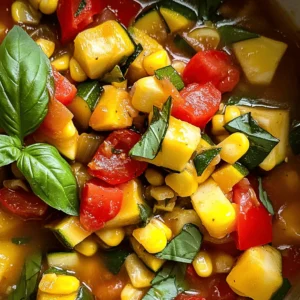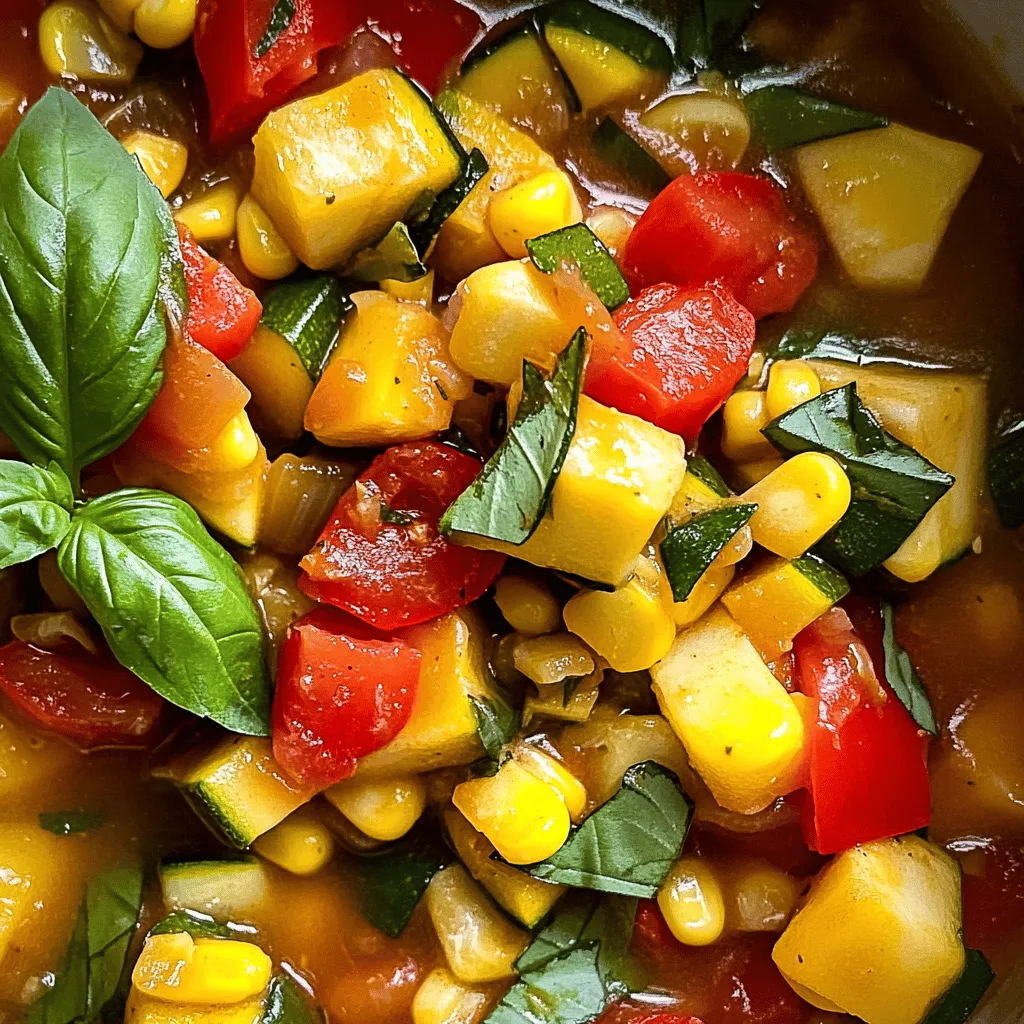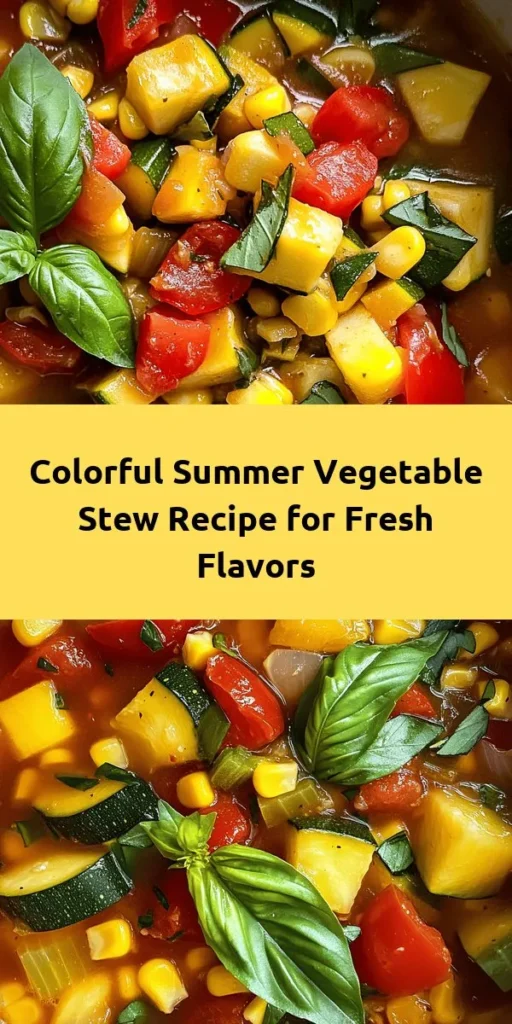Summer is a season synonymous with vibrant colors, fresh produce, and an array of flavors that can elevate any meal. One dish that beautifully encapsulates the essence of summer is the Summer Vegetable Stew. This hearty, yet light dish is a celebration of seasonal ingredients and offers a nutritious, wholesome meal that can be enjoyed by anyone, regardless of dietary preferences. Whether you are a vegan, gluten-free eater, or simply someone who enjoys a good, hearty stew, this recipe is adaptable to fit your needs while being packed with flavor and nutrition.
The Appeal of Summer Vegetable Stew
Cooking with fresh summer produce not only enhances the flavor of your meals but also contributes significantly to your health. Seasonal vegetables like zucchini, bell peppers, and tomatoes are bursting with vitamins, minerals, and antioxidants, making them essential components of a balanced diet. Eating in season means that you are consuming produce at its peak freshness, which not only tastes better but also retains more nutritional value.
Moreover, the comfort of a stew cannot be overstated, especially during the warmer months when outdoor gatherings and family meals are abundant. A Summer Vegetable Stew serves as a versatile and satisfying option for any occasion, whether it’s a casual weeknight dinner or a festive summer gathering. This dish not only nourishes the body but also warms the heart with its rich flavors and inviting aromas.
Ingredient Breakdown
Overview of Key Ingredients
The beauty of Summer Vegetable Stew lies in its simplicity and the array of fresh vegetables that can be incorporated. Here’s a breakdown of the key ingredients that bring this dish to life:
– Zucchini: This mild-flavored vegetable is a staple in summer cooking. Rich in vitamins A and C, as well as potassium, zucchini adds moisture and a soft texture to your stew.
– Yellow Squash: Similar to zucchini, yellow squash is another summer favorite. It is low in calories yet high in nutrients, including vitamin C, which supports your immune system.
– Bell Pepper: Available in various colors, bell peppers add not only a pop of color but also a sweet crunch. They are an excellent source of vitamins A and C, and their antioxidants help combat inflammation.
– Onion: Onions provide a foundational flavor in any stew. Packed with antioxidants, they contribute to heart health while adding depth to the dish.
– Garlic: Known for its aromatic quality and health benefits, garlic adds a robust flavor and is rich in allicin, which has numerous health-promoting properties.
– Cherry Tomatoes: These bite-sized tomatoes burst with sweetness and acidity, enhancing the overall flavor of the stew. They are rich in vitamins C and K, as well as lycopene, a powerful antioxidant.
– Corn: Sweet corn adds a delightful crunch and natural sweetness to the stew. It is high in fiber and provides essential nutrients like B vitamins and magnesium.
– Green Beans: These provide a satisfying texture and a fresh green flavor. Rich in vitamins A, C, and K, as well as fiber, green beans are a nutritious addition.
Herbs and Spices
Herbs and spices play a crucial role in elevating the flavor profile of your Summer Vegetable Stew. The following seasonings are essential:
– Dried Thyme: Thyme adds a subtle earthiness that complements the sweetness of the vegetables. It’s known for its antimicrobial properties and enhances the overall aroma of the dish.
– Basil: This fragrant herb brings a fresh, slightly peppery flavor to the stew. Basil is rich in antioxidants and has anti-inflammatory effects.
– Smoked Paprika: Smoky and slightly sweet, smoked paprika adds depth and complexity to the stew. It’s a great way to infuse a hint of smokiness without the need for meat.
The combination of these herbs and spices not only enhances the taste but also boosts the nutritional value of the stew, making it a flavorful yet healthy option.
Vegetable Broth as a Base
When it comes to the base of the stew, vegetable broth is a game changer. Opting for vegetable broth instead of plain water allows the flavors to deepen and infuse into the vegetables, creating a rich and satisfying dish. You can use store-bought vegetable broth, which is convenient and readily available, or make your own for an extra layer of flavor. Homemade vegetable broth allows you to control the ingredients and salt levels, ensuring a more personalized flavor that can enhance your stew even further.
Preparation Steps
Sautéing the Aromatics
The first step in creating a flavorful Summer Vegetable Stew is to sauté your aromatics. Start by heating a generous splash of olive oil in a large pot over medium heat. Once the oil shimmers, add chopped onions and minced garlic. The key to a perfect sauté is to cook these ingredients gently, allowing them to soften and release their natural sweetness without burning. Stir occasionally, and keep an eye on the heat to ensure they become translucent and fragrant, which typically takes about 3-5 minutes. This initial step lays the flavor foundation of your stew, creating a savory base that will enhance the taste of the vegetables.
Adding Vegetables in Stages
Once your aromatics are beautifully sautéed, it’s time to introduce the rest of your vegetables. The technique of adding vegetables in stages is vital for achieving the best texture and flavor. Start with the heartier vegetables such as zucchini and yellow squash, which can withstand longer cooking times. Stir them into the pot and cook for about 5-7 minutes until they begin to soften.
Next, add the bell peppers and green beans, stirring to combine. These vegetables will require slightly less cooking time, and introducing them at this stage allows them to retain some of their natural crunch. After a few more minutes, toss in the cherry tomatoes and corn. These delicate ingredients cook quickly and should be added last to prevent them from disintegrating.
By layering the vegetables in this way, you ensure that each one retains its unique texture and flavor, contributing to a more satisfying and enjoyable stew. As the vegetables cook together, they will release their juices, mingling with the sautéed aromatics and creating a delicious broth that forms the base of your stew.
As you prepare your Summer Vegetable Stew, keep in mind that this dish is highly customizable. You can modify the vegetables based on what is available in your local market or what you have on hand. The flexibility of this recipe makes it ideal for utilizing the bounty of summer while allowing you to cater to various dietary needs.
Stay tuned for the next part of this article, where we will delve into the finishing touches that elevate your Summer Vegetable Stew to new heights, ensuring it’s not just a meal but a memorable experience.

The Role of Cooking Time for Each Vegetable Type
Cooking time plays a crucial role in achieving the perfect texture and flavor balance in your summer vegetable stew. Different vegetables have varying cooking times, and understanding these differences can elevate your dish from good to great. For instance, root vegetables like carrots and potatoes generally require longer cooking times to become tender, while softer vegetables such as zucchini and bell peppers cook more quickly.
When adding vegetables to your stew, start with those that need the most time to soften. In this recipe, begin with the onions, carrots, and potatoes, allowing them to sauté for a few minutes before introducing quicker-cooking options such as zucchini, corn, and bell peppers. This staggered approach ensures that each vegetable retains its unique texture and flavor profile, contributing to a well-rounded and delicious stew.
Simmering for Flavor Development
Simmering is a fundamental technique in the preparation of a rich and flavorful vegetable stew. The process allows the ingredients to meld together, creating a harmonious blend of tastes. As the stew simmers, the vegetables release their natural juices and flavors, enriching the broth and enhancing the overall dish.
The importance of cooking time during the simmering stage cannot be overstated. Ideally, your stew should simmer for at least 30 minutes. This timeframe allows the flavors to deepen and develop fully, resulting in a robust and satisfying dish. To check for doneness, look for visual cues: the vegetables should be tender, yet still hold their shape. Additionally, the broth should be fragrant, inviting you to dive in with a spoon.
Customization and Variations
Substituting Seasonal Vegetables
One of the joys of making a summer vegetable stew is its adaptability. Seasonal vegetables can be swapped in and out depending on what you have available or what’s at its peak in the market. For a spring version, consider using asparagus or artichokes, while fall might call for hearty squash or sweet potatoes.
You can also enhance the stew’s nutritional profile by incorporating proteins. Adding lentils or beans not only makes the dish heartier but also boosts its protein content, making it a complete meal. Chickpeas or black beans can be excellent choices, offering a creamy texture and additional fiber.
Spice Level and Flavor Adjustments
Adjusting the spice level of your stew is another way to customize it to your taste preferences. For a milder flavor, consider omitting spicy ingredients or using sweet paprika instead of hot. If you enjoy a bit of heat, red pepper flakes or diced jalapeños can elevate the dish significantly.
Herbs also play a pivotal role in flavor development. Fresh herbs like basil, parsley, or thyme can be added during the simmering process for a fresh flavor boost. Alternatively, dried herbs can be sprinkled in at the beginning to infuse the stew with their aromas as it cooks. Don’t hesitate to experiment with your favorite herbs and spices to find the perfect balance for your palate.
Serving Suggestions
Presentation Tips
The presentation of your summer vegetable stew can enhance the dining experience. Consider garnishing your stew with freshly chopped basil or parsley just before serving for a pop of color and freshness. A drizzle of high-quality olive oil can also add richness and depth to the dish.
Pair your stew with crusty bread for dipping, or serve it alongside a light salad for a refreshing contrast. A sprinkle of grated parmesan or feta cheese on top can add a delightful creaminess that complements the stew’s texture.
Storage and Reheating
Leftovers can be a blessing, and storing your summer vegetable stew is straightforward. Allow the stew to cool completely before transferring it to an airtight container. Properly stored, it can last in the refrigerator for up to three days. For longer storage, consider freezing portions in freezer-safe bags or containers for up to three months.
When reheating, gently warm the stew on the stovetop over low heat, stirring occasionally to ensure even heating. If the stew has thickened during storage, add a splash of vegetable broth or water to return it to your desired consistency.
Health Benefits of Summer Vegetable Stew
Incorporating a variety of vegetables in your diet offers numerous health benefits, and a summer vegetable stew is an excellent way to achieve this. The diverse colors and types of vegetables not only make the dish visually appealing but also provide a wide array of vitamins, minerals, and antioxidants necessary for overall health.
One of the standout benefits of consuming vegetables is their high fiber content. Fiber plays a crucial role in promoting healthy digestion and can aid in maintaining a feeling of fullness, making it easier to manage your weight. Furthermore, a diet rich in colorful vegetables ensures you are getting a variety of nutrients essential for optimal health, including vitamins A and C, potassium, and folate.
Conclusion
Making a summer vegetable stew is a delightful culinary adventure that combines fresh, seasonal ingredients with rich flavors and aromas. This dish is not only a celebration of summer’s bounty but also a versatile canvas that allows for creativity and customization.
By experimenting with various vegetables, proteins, and spices, you can create a stew that is uniquely yours. Whether enjoyed as a light meal on a warm day or as a cozy dinner in cooler months, this vegetable stew promises satisfaction and nourishment. Embrace the joy of cooking with seasonal ingredients, and let your creativity shine in every bowl you serve.



